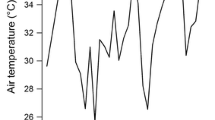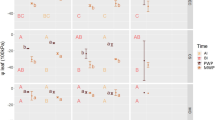Abstract
The present studies have shown Laurus nobilis L. to be a drought tolerant species. When the plant was first subjected to dehydration, the rate of net photosynthesis decreased from Pn = (8–10) to –1 μmol/(m2 s) and to –3 μmol/(m2 s) during the second dehydration before it was subsequently irrigated. The rewatering on August 5 and August 8 promoted a sharp burst of this parameter, but the Pn value was restored to its original level only after August 8. Soil drought caused a drop in a rate of transpiration from 65–70 to 10 mg/(m2 s). Watering soil up to a 15% moisture level brought an increase in E = 25 mg/(m2 s), but only the second watering managed to fully restore it to the initial value. Apical growth of the plants was closely correlated with soil moisture. As the soil moisture was reduced to W = 15–5%, the terminal growth reached a saturation point and started to plateau. Watering the soil up to W = 15% promoted apical growth by 4 mm. Reducing soil moisture to W = 3–4% caused a complete cessation of the growth. Subsequent watering to W = 27–28% led to a gradual and complete recovery of turgor and an increase in the growth rate up to 6–8 mm per day. The surface response functions Pn = f(I, W) and E = f(I, W) allowed us to determine conditions and levels of potential maximums and boundaries of the areas of optimum photosynthesis and transpiration: optimum Pn = 8–9 μmol/(m2 s) with I = 900–1400 μmol/(m2 s) and W = 17–24% and the optimum E = 25–35 mg/(m2 s) with I = 1000–1400 μmol/(m2 s) and W = 16–24%.
Similar content being viewed by others
References
Molchanov, A.G., A simple model for estimating the water availability for day variability of light curves of photosynthesis, Mat. Biol. Bioinf., 2012, vol. 7, no. 1, pp. 197–205.
Galaktionov, I.I., Vu, A.V., and Osin, V.A., Dekorativnaya dendrologiya (Decorative Dendrology), Moscow: Vysshaya shkola, 1967.
Il’nitskii, O.A., Ushkarenko, V.A., Fedorchuk, M.I., Radchenko, S.S., and Bondarchuk, S.V., Metodologiya i pribornaya baza fitomonitoringa (Methodology and Instrumentation of Phytomonitoring), Kherson: Kherson. gos. agrarn. univ., 2012.
Plugatar’, Yu.V., Nikitsky Botanical Garden as a scientific institution, Vestn. Ross. Akad. Nauk, 2016, vol. 86, no. 2, pp. 120–126.
Meletiou-Christou, M.S. and Rhizopoulou, S., Constraints of photosynthetic performance and water status of four evergreen species co-occurring under field conditions, Greece Bot. Stud., 2012, vol. 53, pp. 325–334.
Oppenheimer, H.R. and Leshem, B., Critical thresholds of dehydration in leaves of Nerium oleander L., Protoplasma, 1966, vol. 61, pp. 302–321.
Serrano, L., Peñuelas, J., Ogaya, R., and Savé, R., Tissue–water relations of two co-occurring evergreen Mediterranean species in response to seasonal and experimental drought conditions, J. Plant Res., 2005, vol. 118, pp. 263–269.
Varone, L., Varone, L., and Gratani, L., Physiological response of eight Mediterranean maquis species to low air temperatures during winter, Photosynthetica, 2007, vol. 45, pp. 385–391.
Delaney, K.J., Injured and uninjured leaf photosynthetic responses after mechanical injury on Nerium oleander leaves, and Danaus plexippus herbivory on Asclepias curassavica, Plant Ecol., 2008, vol. 199, pp. 187–200.
Galmés, J., Medrano, H., and Flexas, J., Photosynthetic limitations in response to water stress and recovery in Mediterranean plants with different growth forms, New Phytol., 2007, vol. 175, pp. 81–93.
Maatallah, S., Ghanem, M.E., Albouchi, A., Bizid, E., and Lutts, S., A greenhouse investigation of responses to different water stress regimes of Laurus nobilis trees from two climatic regions, J. Arid. Environ., 2010, vol. 74, pp. 327–337.
Rhizopoulou, S. and Mitrakos, K., Water relations of evergreen sclerophylls. I. Seasonal changes in the water relations of eleven species from the same environment, Ann. Bot., 1990, vol. 65, pp. 171–178.
Christodoulakis, N.S. and Mitrakos, K.A., Structural analysis of sclerophylly in eleven evergreen phanerophytes in Greece, in Plant Response to Stress, Tenhunen, J.D., Catarino, F.M., Lange, O.L., and Oechel, W.C., Eds., Berlin: Springer-Verlag, 1987, pp. 547–551.
Author information
Authors and Affiliations
Corresponding author
Additional information
Original Russian Text © A.V. Pashtetsky, Yu.V. Plugatar, O.A. Ilnitsky, S.P. Korsakova, 2018, published in Rossiiskaya Sel’skokhozyaistvennaya Nauka, 2018, No. 1, pp. 13–17.
About this article
Cite this article
Pashtetsky, A.V., Plugatar, Y.V., Ilnitsky, O.A. et al. The Relationship between Drought Tolerance of Laurus nobilis L. and Environmental Factors in Conditions of the Southern Coast of Crimea. Russ. Agricult. Sci. 44, 131–136 (2018). https://doi.org/10.3103/S1068367418020131
Received:
Published:
Issue Date:
DOI: https://doi.org/10.3103/S1068367418020131




